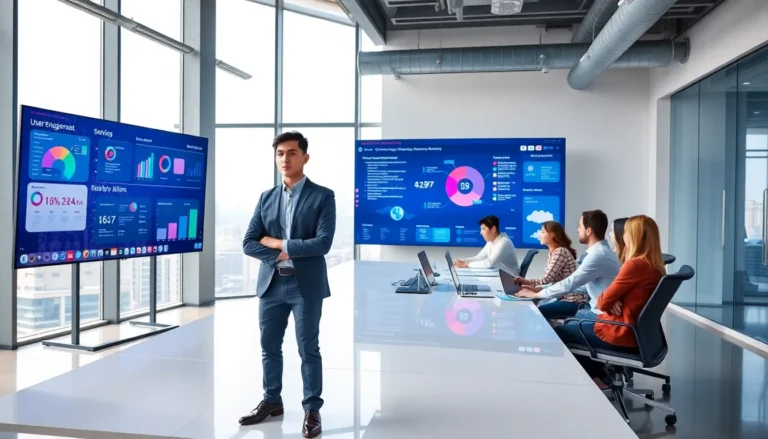Table of Contents
ToggleWhen it comes to keeping the water flowing smoothly in any property, a little maintenance goes a long way. Imagine waking up to a surprise shower—courtesy of a leaky pipe or a malfunctioning water heater. Not exactly the morning bliss anyone dreams of! That’s why having a water system maintenance checklist is essential. It’s like having a superhero sidekick for your plumbing, ready to save the day before disaster strikes.
Importance Of Water System Maintenance
Regular maintenance of water systems protects properties from unexpected issues. It prevents leaks, major damage, and costly repairs. Monitoring water pressure and flow ensures systems function efficiently. Addressing small problems early avoids larger complications later.
A maintenance checklist helps identify areas needing attention. Checking pipes and fixtures for signs of wear provides insights into system health. Regular inspections prevent clogs that lead to backups and disruptions.
Water heaters require specific attention. Flushing sediment buildup every six months extends their lifespan. Inspecting temperature settings promotes efficiency and safety.
Filters play a critical role in water quality. Regularly changing filters prevents contaminant buildup and maintains safe drinking water. Proper maintenance ensures clean water throughout the property.
Maintaining irrigation systems conserves water and promotes healthy landscaping. Inspecting for leaks saves resources and enhances plant growth. Evaluating sprinkler heads and timers ensures efficient watering practices.
Compliance with local regulations enhances system reliability. Understanding codes related to water systems helps avoid legal issues. Following these guidelines fosters a safe environment for occupants.
Budgeting for regular maintenance proves economically smart. Investing in preventative care reduces long-term repair costs. Prioritizing maintenance leads to improved water system performance.
Maintaining water systems is crucial for property integrity, occupant health, and cost-efficiency. A proactive approach, including a comprehensive checklist, drives effective management and supports sustainable practices.
Key Components Of A Water System
Effective water systems encompass several essential components, each playing a crucial role in maintaining water quality and accessibility.
Water Sources
Water sources include natural bodies like rivers, lakes, and groundwater. Different properties may utilize various sources based on geographical locations. Water quality testing is paramount, ensuring contaminants remain within acceptable limits. Regular assessments also establish safe usage for residents. Seasonal changes can impact water availability, requiring ongoing monitoring for optimal supply management.
Distribution Systems
Distribution systems consist of a network of pipes, pumps, and valves that transport water from sources to end-users. Properly functioning pipes prevent leaks and reduce water loss. Regular maintenance checks include inspecting joints and fittings for wear. Increased water pressure may indicate potential blockages that could cause further issues. Monitoring flow rates ensures efficient delivery of water, meeting the needs of occupants effectively.
Treatment Facilities
Treatment facilities focus on purifying water before distribution. Processes like filtration, chlorination, and sedimentation remove harmful substances. Regular maintenance of equipment like pumps and filters is critical for effective operation. Scheduled inspections help identify areas needing repairs or upgrades. Compliance with health regulations ensures water safety for all users, maintaining public trust in the water supply system.
Water System Maintenance Checklist
A water system maintenance checklist ensures a property’s systems function optimally. Consistent reinforcement of maintenance actions preserves water quality and addresses potential issues early.
Routine Inspections
Conducting routine inspections identifies wear and tear in pipes and fixtures. Inspect all components, including faucets, toilets, and irrigation systems, for leaks or signs of damage. Checking connections and joints for corrosion or loose fittings is vital. Scheduling inspections at least twice a year keeps systems running smoothly. Noticing small problems during inspections can prevent larger complications down the road.
Water Quality Testing
Regular water quality testing promotes safe water for residents. Test samples should include checks for contaminants like bacteria, lead, and nitrates. Monitoring levels of pH and chlorine ensures compliance with health regulations. Scheduled testing every six months provides clear insights into water quality trends. Addressing any detected issues promptly protects occupant health in the long term.
Equipment Maintenance
Maintaining equipment supports overall water system efficiency. Clean and replace filters based on manufacturer recommendations to avoid contaminant buildup. For water heaters, flushing sediment out at least once a year extends their lifespan. Equipment, including pumps and valves, must undergo regular checks for functionality. Staying proactive about equipment upkeep fosters smoother operation of the entire water system.
Emergency Preparedness
Establishing emergency preparedness procedures mitigates risks in crises. Develop a response plan for potential issues, like leaks or major system failures. Training staff on emergency protocols ensures a quick response. Maintain contact information for local utilities and repair services for swift action. Practicing drills prepares everyone for real emergencies, enhancing property resilience and safety.
Best Practices For Effective Maintenance
Implementing best practices for water system maintenance maximizes efficiency and minimizes long-term costs. Consider the following procedures to enhance performance.
Scheduled Maintenance
Routine maintenance ensures system reliability and longevity. Schedule inspections of all water sources and distribution systems at least twice yearly. Prioritize flushing water heaters annually to remove sediment that can reduce efficiency. Check filters regularly, replacing them as needed to maintain water quality. Inspect pipes and fixtures for signs of wear during each visit to catch potential issues before they escalate. Allocate time for evaluating irrigation systems to promote healthy landscaping while conserving water.
Record Keeping
Accurate documentation plays a crucial role in maintenance efficiency. Maintain a detailed log of inspections, repairs, and replacements to track system performance over time. Record dates of filter changes and water quality tests to ensure compliance with health standards. Note any issues discovered during inspections, along with the actions taken to address them. This data can identify trends and assist in scheduling future maintenance more effectively. A thorough record-keeping system can enhance accountability and streamline communication among property management teams.
Conclusion
Regular maintenance of water systems is essential for ensuring their efficiency and longevity. By following a well-structured checklist, property owners can proactively address potential issues before they escalate into costly repairs. This not only safeguards the integrity of the property but also promotes the health and safety of its occupants.
Investing in routine inspections and timely maintenance can lead to significant savings over time. A comprehensive approach that includes monitoring water quality and maintaining equipment is key to achieving optimal performance. Ultimately, prioritizing water system maintenance is a smart strategy for any property owner looking to enhance reliability and reduce long-term expenses.








